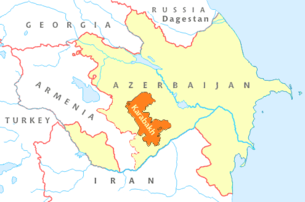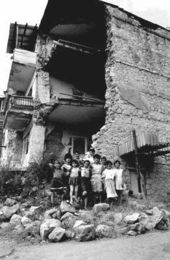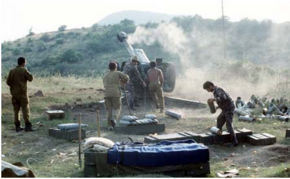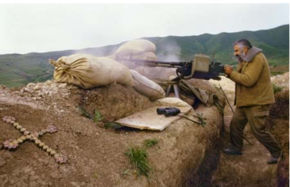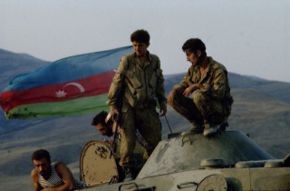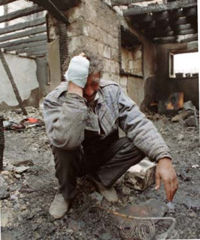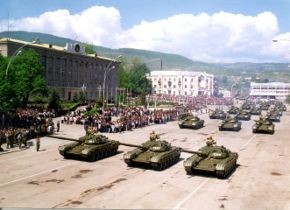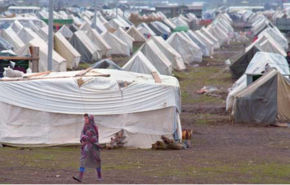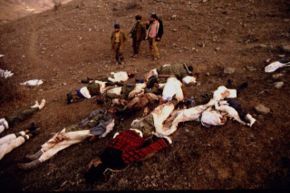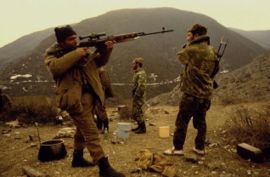Nagorno-Karabakh War
2007 Schools Wikipedia Selection. Related subjects: Recent History
| Nagorno-Karabakh War | |||||||||||
|---|---|---|---|---|---|---|---|---|---|---|---|
 Armenian troops fighting against Azeri forces from trenches in Karabakh. |
|||||||||||
|
|||||||||||
| Combatants | |||||||||||
| Commanders | |||||||||||
| Samvel Babayan, Hemayag Haroyan, Monte Melkonian, Vazgen Sarkisyan, Arkady Ter-Tatevosyan |
İsgandar Hamidov, Suret Huseynov, Rahim Gaziev, Shamil Basayev |
||||||||||
| Casualties | |||||||||||
| ~6,000 dead, 20,000 wounded |
~17,000 dead, 30,000 wounded |
||||||||||
| 1 Unrecognized 2 Involvement disputed |
|||||||||||
| Nagorno-Karabakh War |
|---|
| Black January – Khojaly – Maraghar – Ring – Sumgait – Mardakert and Martuni – Summer - Kelbajar - Shusha |
| Conflicts in the former Soviet Union |
|---|
| Nagorno-Karabakh – South Ossetia – Abkhazia – Georgia – North Ossetia – Transnistria – Tajikistan – 1st Chechnya – Dagestan – 2nd Chechnya |
The Nagorno-Karabakh War was an armed conflict that took place from February 1988 to May 1994, in the small ethnic enclave of Nagorno-Karabakh in southwestern Azerbaijan, between the ethnic Armenian majority in the enclave and in the neighboring Republic of Armenia and the Republic of Azerbaijan. As the war progressed, Armenia and Azerbaijan, both former Soviet Republics, became enveloped in a protracted, undeclared war as the latter attempted to curb a secessionist movement in Nagorno-Karabakh. The enclave's parliament had voted in favor of uniting itself with Armenia and a referendum was held with the vast majority of the Karabakh population voting in favour of independence. The demand to unify with Armenia, which proliferated in the late 1980s, began in a relatively peaceful manner; however, in the following months, as the Soviet Union's disintegration neared, it gradually grew into an increasingly violent conflict between the two ethnic groups.
The war was the most destructive ethnic conflict in both terms of lives and property that emerged after the Soviet Union collapsed in December 1991. Interethnic fighting between the two broke out shortly after the parliament of Nagorno-Karabakh, an autonomous oblast in Azerbaijan, voted to unify the region with Armenia on February 20, 1988. Along with the secessionist movements in the Baltic republics of Estonia, Latvia, and Lithuania, the succeeding movement characterized and played a large role in bringing the downfall of the Soviet Union. As Azerbaijan declared its independence from the Soviet Union and removed the powers held by the enclave's government, the Armenian majority voted to secede from Azerbaijan, and in the process proclaimed the enclave the Republic of Nagorno-Karabakh.
Full-scale fighting erupted into a low-intensity conflict in the late winter of 1992. International mediation by several groups including Europe's OSCE failed to bring an end resolution that both sides could work with. In the spring of 1993, Armenian forces captured regions outside the enclave itself, threatening the involvement of other countries in the region. By the end of the war in 1994, the Armenians were in full control of not only the mountainous enclave but also held and currently control approximately 14% of Azerbaijan's territory. A Russian-brokered cease fire was signed in May of 1994 and peace talks, mediated by the OSCE Minsk Group, have been held ever since by Armenia and Azerbaijan.
Roots of the conflict
The territorial ownership of Nagorno-Karabakh today is still a heavily disputed issue between Armenia and Azerbaijan. Called Artsakh by Armenians, referring to the name it went by under the rule of Armenian princes, its history spans several centuries, where it came under the control of several different empires. Debate, however, is mired mainly in the aftermath of World War I. Shortly before the Ottoman Empire's capitulation in the war, the Russian Empire collapsed in November 1917 and fell into the control of the Bolsheviks. The three nations of the Caucasus, Armenia, Azerbaijan, and Georgia, previously under the rule of the Russians, declared their independence to form the Transcaucasian Federation.
Fighting soon broke out between the Democratic Republic of Armenia and the Democratic Republic of Azerbaijan in three specific regions: Nakhichevan, Zangezur (today the Armenian province of Syunik), and Karabakh itself. Armenia and Azerbaijan quarreled as to where the boundaries would fall in accordance to the three provinces. The Karabakh Armenians attempted to declare their independence but failed to make contact with the Republic of Armenia.
Soviet division
Two months later, the Soviet 11th Army invaded the Caucasus and within three years, the Caucasian republics were formed into the Transcaucasian SFSR of the Soviet Union. The Bolsheviks, thereafter created a seven-member committee, the Caucasus Bureau (also written as Kavburo), which under the supervision of the future Soviet ruler Joseph Stalin, then the acting People's Commissar for Nationalities, was tasked to head up matters in the Caucasus. Although the committee voted 4-3 in favour of allocating Karabakh to the newly created Soviet Socialist Republic of Armenia, protestations made by Azerbaijani leaders including the Communist Party leader of Azerbaijan Nariman Narimanov and an anti-Soviet rebellion in the Armenian capital Yerevan in 1921 embittered relations between Armenia and Russia. These factors lead the committee to reverse its decision and award Karabakh to Soviet Azerbaijan in 1921, and later into Azerbaijan proper in 1923; leaving it with a population that was 94% Armenian. The capital was moved from Shusha to Khankendi where it was later renamed Stepanakert.
Armenian and Azeri scholars have speculated that this was an attempt by Russia in accordance to the theory of " divide and rule." This can be seen, for example, by the odd placement of the Nakhichevan exclave which is separated by Armenia but is a part of Azerbaijan. Armenia has always refused to recognize this decision and continued to protest its legality in the ensuing decades under Soviet rule.
February 1988, the revival of the Karabakh issue
| For Azerbaijan the issue of Karabakh is a matter of ambition, for the Armenians of Karabakh, it is a matter of life or death —Soviet dissident and human rights activist Andrei Sakharov |
As the new general secretary of the Soviet Union, Mikhail Gorbachev came to power in 1985, his plans to reform the Soviet Union were two policies called Perestroika and Glasnost. While perestroika had more to do with economic reform, glasnost or openness granted limited freedom to Soviet citizens to express grievances about the Soviet system itself and its leaders. Capitalizing on this, the leaders of National Council of Karabakh decided to vote in favour of unifying the autonomous region with Armenia on February 20, 1988. Karabakh Armenian leaders complained that the region had neither Armenian language textbooks in schools nor in television broadcasting. Azerbaijan's Communist Party General Secretary Heidar Aliev had extensively attempted to " Azerify" the region and increase the influence and the number of Azeris living in Nagorno-Karabakh, while at the same time reducing its Armenian population (In 1987, Aliev would step down as General Secretary of Azerbaijan's Politbureau).
The movement was spearheaded by popular Armenian figures and also members of the Russian intelligentsia such as dissident and Nobel Laureate Andrei Sakharov. Prior to the declaration, Armenians had begun to protest and stage workers strikes in Yerevan, demanding a unification with the enclave; prompting Azeri counter-protests in Baku. In reaction to the protests, Gorbachev stating that the borders between the republics would not change; citing it in accordance to Article 78 of the Soviet constitution. Gorbachev also stated that several other regions in the Soviet Union were yearning for territorial changes and redrawing the boundaries in Karabakh would thus set a dangerous precedent. Armenians viewed the 1921 Kavburo decision with disdain and felt that in their efforts, they were correcting a historical error under the principle of self-determination, a right also granted in the constitution. Azeris, on the other hand, found such calls for relenquishing their territory by the Armenians unfathomable and aligned with Gorbachev's position.
Sumgait
| Congratulations on your earthquake. Nature has spared us the trouble —alleged quote cabled by Azerbaijan to Armenians after the Leninakan Earthquake |
Ethnic infighting soon broke out between Armenians and Azerbaijanis living in Karabakh. On February 22, 1988, a direct confrontation between Azerbaijanis and Armenians near Askeran (in Nagorno-Karabakh, on the road Stepanakert - Agdam) degenerated into a skirmish. During the clashes, which left about 50 Armenians wounded, a local policeman, purportedly an Armenian, shot dead two Azerbaijani youths. On February 27, 1988 while speaking on Baku's Central television, the USSR Deputy Procurator Alexander Katusev mentioned the nationality of those killed. Within hours, a pogrom against Armenian residents began in the city of Sumgait, 25 kilometers north of Baku, where many Azerbaijani refugees resided, resulting in the deaths of 32 people, according to official Soviet statistics.
The manner of which many Armenians were killed reverberated amongst Armenians who felt the pogrom was backed by government officials to intimidate those involved in the Karabakh movement. As the violence escalated, Gorbachev finally decided to send in Soviet Interior troops to Armenia in September 1988. By October 1989, over 100 people were estimated to have been killed since the revived idea of unification with Karabakh in February 1988. The issue temporarily absolved as a devastating earthquake hit the Armenian city of Leninakan on December 7 1988, killing over 25,000 people.
Gorbachev's attempts to stabilize the region were to no avail as both sides were equally intransigent. Armenians refused to allow the issue to subside despite concessions made by Gorbachev, including a promise of 400 million rubles packaged to revitalize Armenian language textbooks and television programming in Karabakh. Azerbaijan was unwilling to cede any territory to Armenia. Furthermore, the newly formed Karabakh Defense Committee, which comprised eleven members including the future president of Armenia Levon Ter-Petrosyan, were jailed by Moscow officials in the ensuing chaos after the quake. Such actions polarized relations between Armenia and the Kremlin; Armenians lost faith in Gorbachev and despised him even more in his mishandling of the earthquake and his uncompromising stature in regards to Nagorno-Karabakh.
Black January
| If Gorbachev wants a second Afghanistan, he will get it in Azerbaijan. —Ekhtibar Mamedov, Azeri representative of the Popular Front in Baku |
Interethnic strife began to take a toll on both countries' populations, forcing most of the Armenians in Azerbaijan to flee back to Armenia and most of the Azeris in Armenia to Azerbaijan. In January 1990, another pogrom against Armenians in Baku forced Gorbachev to declare a state of emergency and sent MVD troops to restore order. A curfew was established and violent clashes between the soldiers and the surging Azerbaijan Popular Front were common, in one instance over 120 Azeris and eight MVD soldiers were killed in Baku. During this time, however, Azerbaijan's Communist Party had fallen and that the belated order to send the MVD had more to do with keeping the Party in power than merely to protect the city's Armenian population. The events, referred to as Black January, also delineated the relations between Azerbaijan and Russia.
Other instances of fighting spread through other cities in Azerbaijan, including in December of that year in Ganja, where eight people were killed, four of them soldiers, when Soviet army units attempted to stop attacks directed at Armenians. The situation in Nagorno-Karabakh had grown so out of hand that, in January 1989, the Soviet leadership in Moscow temporarily took control of the region, a move welcomed by many Armenians. In the summer of 1989, Popular Front leaders and their ever-increasing supporters managed to pressure the Azeri SSR to instigate a railway and air blockade against Armenia, effectively crippling Armenia's economy as 85% of the cargo and goods arrived through rail traffic (this also cut off Nakhichevan from the rest of the Soviet Union).
Operation Ring
In the spring of 1991, President Gorbachev held a special countrywide referendum called the Union Treaty which would decide if the Soviet republics would remain together. Newly elected, non-communist leaders had come into place in the Soviet republics including Boris Yeltsin of Russia (Gorbachev remained the president of the Soviet Union proper), Levon Ter-Petrosyan of Armenia and Ayaz Mutalibov of Azerbaijan. Armenia and several other republics boycotted the referendum (Armenia would hold its own referendum and declared its independence from the USSR on September 21, 1991), whereas Azerbaijan voted in compliance to the Treaty. As many Armenians and Azeris in Karabakh began an arms build up (by acquiring weaponry located in caches throughout Karabakh) in order to defend themselves, Mutalibov touted support from Gorbachev in launching a joint military operation (in this case, the Azerbaijani militia force called the OMON) in order to disarm Armenian militants in the region. Known as Operation Ring, the assault forcibly deported Armenians living in villages in the region of Shahumyan. It was perceived by both Soviet officials from the Kremlin and from the Armenian government as a method of intimidating the Armenian populace to giving up their demands for unification.
The events were counter-productive to what the operation had originally sought to accomplish. The initial resistance put up by Armenians managed to recruit more irregulars from Armenia and only reinforced the conclusion to Armenians that the only solution to the Karabakh conflict was through an out-right armed conflict. Monte Melkonian, an Armenian-American who had served in revolutionary groups in the 1980s and would later rise to be perhaps the most famed commander of the war, argued that Karabakh be "liberated" and contended that if it remained in Azeri hands, the region of Syunik would then be annexed by the Azeris and the rest of Armenia would follow thereafter, concluding "the loss of Artsakh could be the loss of Armenia." Velayat Kuliev, a writer and the deputy director of Azerbaijan's Literary Institute disputed this, "Lately the Armenian nationalists, including some quite influential people, have started talking again about 'Greater Armenia'. Its not just Azerbaijan. They want to annex parts of Georgia, Iran and Turkey."
Weapons vacuum
| Here's perestroika for you. The Russians gave us weapons, and they gave the Armenians weapons. And they are guilty. —Alakhverdi Bagirov, commander of Popular Front forces near Askeran |
As the disintegration of the USSR became a reality for Soviet citizens in the autumn of 1991, both sides sought to acquire weaponry from military caches located throughout Karabakh. The initial advantage tilted in Azerbaijan's favour. During the Cold War, the Soviet military doctrine for defending the Caucasus had outlined a strategy where Armenia would be a combat zone in the case NATO member Turkey invaded from the west. Thus, the Armenian SSR had only three divisions and no airfields while the Azeri SSR had a total of five divisions and five military airfields. Furthermore, Armenia had approximately 500 railroad cars of ammunition, dwarfed by the Azeris' 10,000.
As MVD forces began pulling out, they bequeathed the Armenians and Azerbaijanis a vast arsenal of ammunition and stored armored vehicles. The government forces initially sent by Gorbachev three years earlier were from other republics of the USSR and many had no wish to remain any longer. Most were poor, young conscripts and many simply sold their weapons for cash or even vodka to either side, some even trying to sell tanks and APCs. The Azeris purchased a large quantity of these vehicles, as reported by the Azeri Foreign Ministry in November 1993, which said it had acquired 286 tanks, 842 armored vehicles, and 386 artillery pieces from the power vacuum. Several black markets also sprang up which included weaponry from the West.
Further evidence also showed that Azerbaijan received substantial military aid and provisions from Iran, Israel, Turkey, and numerous Arab countries. Most weaponry was Russian-made or came from the former Eastern bloc countries however some improvisation was made by both sides. The Armenian Diaspora managed to donate a significant amount of money to be sent to Armenia and even managed to push for legislation in the United States Congress to pass a bill entitled Section 907 of the Freedom Support Act in response to Azerbaijan's blockade against Armenia; restricting a complete ban on military aid from the United States to Azerbaijan in 1992. While Azerbaijan charged that the Russians were initially helping the Armenians, it was said that "the Azeri fighters in the region [were] far better equipped with Soviet military weaponry than their opponents."
With Gorbachev resigning as USSR General-Secretary on December 26, 1991, the remaining republics including the Ukraine, Belarus and Russia declared their independence and the Soviet Union ceased to exist on December 31, 1991. This dissolution gave way to any barriers that were keeping Armenia and Azerbaijan from waging a full scale war. One month prior, on November 21, the Azerbaijani Parliament rescinded Karabakh's status as an autonomous oblast and renamed it "Xankandi". In response, on December 10, a referendum was held in Karabakh by parliamentary leaders (with the local Azeri community boycotting it) where the Armenians voted overwhelmingly in favour of independence. On January 6 1992, the region declared its independence from Azerbaijan.
The withdrawal of the Soviet interior forces from Nagorno-Karabakh in the Caucasus region was only temporary. By February 1992, the former Soviet forces, now consolidated as the Commonwealth of Independent States (CIS). While Azerbaijan abstained from joining, Armenia, fearing a possible invasion by Turkey in the escalating conflict, entered the CIS which would have protected it under a "collective security umbrella." In January 1992, the CIS forces then moved in and established a headquarters at Stepanakert and took up a slightly more active role in peacekeeping, incorporating old units including the 366th Motorized Regiment and 4th Army, both which desperately attempted to keep the peace between the warring factions. About 1,400 CIS troops were stationed in the capital of Stepanakert and slated for withdrawal by late February.
Building armies
The sporadic battles between Armenians and Azeris that had since intensified after Operation Ring recruited thousands of volunteers into improvised armies from both Armenia and Azerbaijan. In Armenia, a recurrent and popular theme at the time compared and idolized the separatist fighters to the Armenian fedayeen guerilla groups and revered individuals such as Andranik Ozanian and Garegin Njdeh, who fought against the Ottoman Empire during the late 19th and early 20th centuries. In addition to the government's conscription of males aged 18-45, many Armenians volunteered to fight and formed jokats, or detachments, of about forty men, which combined with several others were under the command of a Shtabee Bed, or Chief of Headquarters. Initially, many of these men chose when and where to serve and acted on their own behalf, rarely without any oversight, when attacking or defending areas. Direct insubordination was common as many of the men simply did not show up, looted the bodies of dead soldiers, and commodities such as diesel oil for armored vehicles disappeared only to be sold in black markets. Many women enlisted in the Armenian military; however, they more often served in auxiliary roles such as providing first-aid and evacuating wounded men from the battlefields than taking part in the fighting.
Azerbaijan's military functioned in much the same manner; however, it was more organized during the beginning years of the war's beginning. The Azeri government also conscripted and many Azeris enthusiastically enlisted for combat in the first months after the Soviet Union collapsed. Azerbaijan's National Army consisted of roughly 30,000 men in addition to nearly 10,000 in its OMON paramilitary force and several thousand made up of volunteers from the Popular Front. Suret Huseynov, a wealthy Azeri also improvised by creating his own military brigade, the 709th Azerbaijani Army, and purchasing many weapons and vehicles from the 23rd division's arsenal. İsgandar Hamidov's bozkurt or Grey Wolves brigade also mobilized for action. The government of Azerbaijan also poured a great deal of money into hiring mercenaries from other countries through the revenue it was making from its oil field assets on and near the Caspian Sea. The estimated amount of manpower and military vehicles each political entity involved in the conflict had in the 1993-1994 time period was:
| Entity | Military Personnel | Artillery | Tanks | Armored personnel carriers | Armored fighting vehicles | Fighter aircraft |
|---|---|---|---|---|---|---|
| Republic of Nagorno-Karabakh | 20,000 | 16 | 13 | 120 | N/A | N/A |
| Republic of Armenia | 20,000 | 170 | 160 | 240 | 200 | N/A |
| Republic of Azerbaijan | 42,000 | 330 | 280 | 360 | 480 | 170 |
In an overall military comparison, the number of men eligible for military service in Armenia, of an age group of 17-32 year olds, was 550,000 while in Azerbaijan it was 1.3 million. Most men from both sides had served in the Soviet Army and so had some form of military experience prior to the conflict. About 60% of Karabakh Armenians had served in the Soviet Army. Most Azeribaijanis, while serving in the military were often subject to discrimination and relegated to work in construction battalions rather than fighting corps. Despite the establishment of two officer academies including a naval school in Azerbaijan, the lack of such military experience was one factor that rendered Azerbaijan unprepared for the war.
Spring 1992, Early Armenian victories
Khojaly
| They just shot and shot and shot —Raisa Aslanova, a refugee from Khojaly commenting in an interview to HRW |
Officially, the newly created Republic of Armenia publicly denied any involvement in providing any weapons, fuel, food, or other logistics to the secessionists in Nagorno-Karabakh. However, Ter-Petrosyan's later did admit to supplying them with only logistical supplies and paying the salaries of the separatists but denied sending any of its own men to combat. Armenia was facing a debilitating blockade by the now Republic of Azerbaijan as well as pressure coming from all sides, including Turkey, which had begun to build a close relationship with Azerbaijan. The only land connection Armenia had with Karabakh was through the narrow mountainous Lachin corridor which could only be reached by helicopters. The only airport that existed in Karabakh was in the small town of Khojaly, which was seven kilometers north of Stepanakert with an estimated population of 6,000-10,000 people. Additionally, the town had been serving as an artillery base and since Feburary 23, was shelling Armenian and Russian units in the capital. By late February, Khojaly had largely been cut off. On February 26, Armenian forces, with the aid of armored vehicles in the 366th, mounted an offensive to capture Khojaly.
According to the Azeris and the affirmation of other sources including Human Rights Watch and the Moscow based human rights organization Memorial, after Armenian forces captured Khojaly, they proceeded to massacre several hundred civilians evacuating from the town. Armenian forces had previously stated they would attack the city and left a land corridor for them to escape through. However, when the attack finally began, an Armenian force of approximately 2,000 fighters easily outnumbered and overwhelmed the defenders who along with the civilians attempted to retreat north to the Azeri held city of Agdam. The airport's runway was found to have been intentionally destroyed, rendering it temporarily useless. The attacking forces then went on to pursue those fleeing through the corridor and opened fire upon them, killing scores of civilians. A video shot several days later showed the corpses of both women and children, some burned, dismembered, and mutilated to unrecognizable degrees.
Visits by foreign correspondents also counted similar fates done to Azeri soldiers. Many more froze or starved to death as they trekked over the snow covered hills towards Agdam. Assad Faradzhev, an aide to the region's Azeri governor, also reported that many "women and children had been scalped". Facing such charges, Armenian government officials denied the occurrence of a massacre and pointed to the artillery shelling coming from Khojaly. They alleged that the mutilations had been done by the Azeris themselves, citing an interview by Mutalibov. The Azeri government charged the Armenian government with intentional genocide. The 366th, which after the attack was suspended from withdrawing, also faced scathing criticism and denied participating in the attack. An exact body count was never ascertained but conservative estimates have placed the number to 485.
Subtle admissions of guilt later laid blame on Armenian irregulars acting at their own initiative. Military commanders also pointed out that many of fighters had been from Baku and Sumgait, the sites of the Azeri pogroms against Armenians. The aftermath of the attack erupted in Azerbaijan. Mutalibov, was called to step down from his post by many, with perhaps the most vocal being members of the Popular Front. Despite his protestations, he was charged for failing to protect the civilians in Khojaly and forced to resign amid the hail of criticism on March 6.
The capture of Shusha
In the ensuing months after the capture of Khojaly, Azeri commanders holding out in the region's last bastion of Shusha, began a large scale artillery bombardment with GRAD rocket launchers against Stepanakert. By April, the shelling had forced many of the 50,000 people living in Stepanakert to seek refuge in underground bunkers and basements. Facing ground incursions near the cities outlying areas, military leaders in Nagorno-Karabakh organized an offensive to take the town.
On May 8, a force of several hundred Armenian troops accompanied by tanks and helicopters attacked the Shusha citadel. Fierce fighting took place in the town's streets and several hundred men were killed on both sides. Overwhelmed by the numerically superior fighting force, the Azeri commander in Shusha ordered a retreat and fighting ended on May 9.
The capture of Shusha resonated loudly in neighboring Turkey. Its relations with Armenia had grown better after it had declared its independence from the USSR; however they gradually worsened as a result of Armenia's gains in the Nagorno-Karabakh region. A deep resentment towards Turkey by Armenia predated the Soviet era and this enmity stemmed in part from the Armenian Genocide. Many Armenians collectively referred to Azeris as "Turks" since they are considered ethnic cousins. Turkey's prime minister, Suleyman Demirel said that he was coming under intense pressure by his people to have his country intervene and aid Azerbaijan. Demirel however, was opposed to such an intervention, saying that Turkey's entrance into the war would trigger an even greater Muslim-Christian conflict (Turks are predominantly Muslims).
Turkey never did actively contribute troops to Azerbaijan but did send a great deal of military aid and advisers. In May 1992, the military commander of the CIS forces, Marshal Yevgeny Shaposhnikov, issued a warning to Western nations, especially the United States, to not interfere with the conflict in the Caucasus; stating it would "place us [the Commonwealth] on the verge of a third world war, and that cannot be allowed."
Sealing Lachin
The loss of Shusha led the Azeri parliament to lay the blame on Mamedov, which removed him from power and cleared Mutalibov of any responsibility after the loss of Khojaly; reinstating him as President on May 15 1992. Many Azeris saw this act as a coup in addition to the cancellation of the parliamentary elections slated in June of that year. The Azeri parliament at that time was made up of former leaders from the country's communist regime and the losses of Khojaly and Shusha only aggrandized their desires for free elections to be held. Mutalibov declared a state of emergency and an end to all political demonstrations to sort through the disarray.
To contribute to the turmoil, an offensive was launched by Armenian forces on May 18 to take the city of Lachin in the narrow corridor separating Armenia and Nagorno-Karabakh. The city itself was poorly guarded and, within the next day, Armenian forces took control of the town and cleared any remaining Azeris to open the road that linked the region to Armenia. The taking of the city then allowed an overland route to be connected with Armenia itself with supply convoys beginning to trek up the mountainous region of Lachin to Karabakh.
The loss of Lachin was the final blow to Mutalibov's regime. Demonstations were held despite Mutalibov's ban and an armed coup was staged by Popular Front activists. Fighting between government forces and Popular Front supporters escalated as the political opposition seized the parliament building in Baku as well as the airport and presidential office. Deaths and injuries were relatively low. On June 16, 1992, Abulfaz Elchibey became Azerbaijan's first democratically elected leader and many political leaders from the Azerbaijan Popular Front Party were elected into the parliament. The instigators characterized Mutalibov as an undedicated and weak leader in the war in Karabakh. Elchibey was staunchly against receiving any help from the Russians, instead favoring closer ties to Turkey and stating that Azerbaijan would not join the CIS.
Escalation of the conflict
Azeri Offensive in June 1992
On June 12, 1992, the Azeri military, along with Huseynov's own brigade, used a large amount of tanks, armored personnel carriers and attack helicopters to launch a large three-day offensive from the relatively unguarded region of Shahumian, north of Nagorno-Karabakh, in the process taking back several dozen villages in the Shauhmian region originally held by Armenian forces. Another reason the front collapsed so effortlessly was because it was manned by the same volunteer detachments from Armenia which had abandoned the lines to go back to their country after the capture of Lachin. The offensive prompted the Armenian government to openly threaten Azerbaijan that it would overtly intervene and assist the separatists fighting in Karabakh.
The assault forced Armenian forces to retreat south towards Stepanakert where Karabakh commanders contemplated destroying a vital hydroelectric dam in the Martakert region if the offensive was not halted. An estimated 30,000 Armenian refugees were also forced to flee to the capital as the assaulting forces had taken back nearly half of Nagorno-Karabakh. However, the thrust made by the Azeris grounded to a halt when their armor were driven off by helicopter gunships. It was also revealed that many of the crew members of the armored units in the Azeri launched assault were Russians from the 104th Division based out of Ganja and, ironically enough, so were the units who eventually stopped them. According to an Armenian government official, they were able to persuade Russian military units to bombard and effectively halt the advance within a few days; allowing the Armenian government to recuperate for the losses and reorganize a counteroffensive to restore the original lines of the front.
Renewed fighting
In late June, a new, smaller Azeri offensive was planned, this time against the town of Martuni in the southeastern half of Karabakh. The attack force consisted of several dozen tanks and armored fighting vehicles along with a compliment of several infantry companies massing along the Majgalashen and Jardar fronts near Martuni and Krasnyi Bazar. Martuni's regimental commander, Monte Melkonian, referred now by his men as "Avo", although lacking heavy armor, managed to stave off repeated attempts by the Azeri forces.
In late August 1992, Nagorno-Karabakh's government found itself in a disorderly state and its members resigned on August 17. Power was subsequently assumed by a council called the State Defense Committee which was chaired by Robert Kocharyan, stating it would temporarily govern the enclave until the conflict ended. At this time, Azerbaijan also attacks by fixed wing aircraft, often bombing civilian targets. Kocharyan condemned the international community to what he believed were intentional attempts to kill civilians by the Azeris and also to what he alleged was Russia's passive and unconcerned attitude towards allowing its army's weapons stockpiles to be sold or transferred to Azerbaijan.
There were also reports, for the first time, of incursions by Azeri militants into villages north of Yerevan and Armenia itself, drawing the ire of government officials into strengthening their support for the Karabakh Armenians.
On September 24, Russian defense minister Pavel Grachev, met with the defense ministers of Armenian and Azerbaijan in the Russian coastal town of Sochi in an attempt to sign the sixth cease fire between the two groups. Defense ministers Vazgen Sarkisyan of Armenia and Rahim Gaziev of Azerbaijan negotiated for a two month halt in the fighting. However, before the truce was to take place, Azeri forces backed away from the peace accordance which led Armenian government leaders to announce that they too would in turn refuse to accept it. Attacks were launched by the Azeris and the outlying villages around Martuni were besieged once more; however, Armenian forces were again able to thwart the assaults and launched successful counterattack thereafter.
Winter thaw
As the winter of 1992 approached, both sides largely abstained from launching full scale offensives so as to reserve resources, such as gas and electricity, for domestic use. Despite the opening of an economic highway to the residents living in Karabakh, both Armenia and the enclave suffered a great deal due to the economic blockades imposed by Azerbaijan and while not completely closing it, the material aid sent through Turkey arrived sporadically. Experiencing both food shortages and power shortages, after the close down of the Metsamor nuclear power plant, Armenia's economic outlook appeared bleak: in Georgia, a new bout of civil wars against separatists in Abkhazia and Ossetia began, who raided supply convoys and repeatedly destroyed the only oil pipeline leading from Russia to Armenia. Similar to the winter of 1991-1992, the 1992-1993 winter was especially cold, as many families throughout Armenia and Karabakh were left without heating and hot water. Armenia was however able to sustain food commodities for itself through its agricultural farming.
Other goods such as grain were more difficult to procure. The Armenian Diaspora living in raised money and donated supplies to be sent to Armenia. In December, two shipments of 33,000 tons of grain and 150 tons of infant formula arrived from the United States via the Black Sea port of Batumi, Georgia. In February 1993, the European Community sent 4.5 million ECUs to Armenia. Azerbaijan was also struggling to rehabilitate its petroleum industry, the country's chief export. Its oil refineries were not generating at full capacity and production quotas fell well short of estimates. In 1965, the oil fields in Baku were producing 21.5 million tons of oil annually; by 1988, that number had dropped down to almost 3.3 million. Outdated Soviet refinery equipment and a reluctance by Western oil companies to invest in a war region where pipelines would routinely be destroyed prevented Azerbaijan from fully exploiting its oil wealth.
Summer 1993, the war spills out
Conflicts at home
Despite the grueling winter both countries had suffered, the new year was viewed enthusiastically by both sides. President Elchibey expressed optimism towards bringing an agreeable solution to the conflict with Armenia's Ter-Petrosian. Glimmers of such hope however, quickly began to fade as in January 1993, despite the calls for a new cease fire by Yeltsin and Bush, hostilities in the region brewed up once more. Armenian forces began a new bout of offensives that overran villages in northern Karabakh that had been held by the Azeris since the previous autumn.
Frustration over these military defeats took a toll in the domestic front in Azerbaijan. Azerbaijan's military had grown more disparate and insubordination by defense minister Gaziev and Huseynov's brigade to turn to Russian help ran against Elchibey's policies. Political infighting and arguments on where to shift military units between the country's ministry of the interior, İsgandar Hamidov, and Gaziev led to the latters' resignation on February 20. A political shakedown also was occurring in Armenia when Ter-Petrossian dismissed the country's prime minister, Khosrov Arutyunyan and his cabinet for failing to implement a viable economic plan for the country. Protests by Armenians against Ter-Petrossian's leadership were also suppressed and put down.
Kelbajar
| We're tank-rich! The Azeris are arming two armies—theirs and ours. May God keep Elchibey in good health —Armenian fighters joking after inheriting the vast amounts of abandoned Azeri weaponry |
Situated west of northern Karabakh, out of the boundaries of the region, was the rayon of Kelbajar which bordered alongside Armenia. With a population of about 45,000, the several dozen villages were made up of Azeris and Kurds. In March of 1993, the Armenian-held areas near the Sarsang reservoir in Mardakert were reported to having been coming under attack by the Azeris. After successfully defending the Martuni region, Melkonian's fighters were tasked to move to capture the region of Kelbajar, where the incursions and purported artillery shelling were said to have been coming from. Scant military opposition by the Azeris allowed Melkonian's fighters to quickly gain a foothold in the region and also captured several abandoned armored vehicles and tanks. At 2:45 P.M., on April 2, Armenian forces from two different directions advanced towards Kelbajar in an attack that quickly struck against Azeri armor and troops entrenched near the Ganje-Kelbjar intersection. Azeri forces were unable to halt advances made by Armenian armor units and nearly all died defending the area. The second attack towards Kelbajar also quickly overran the defenders. By April 3, Armenian forces had captured Kelbajar.
The offensive provoked international rancor against the Armenian government, marking the first time Armenian forces had crossed the boundaries of the enclave itself and into Azerbaijan's territory. On April 30, the United Nations Security Council (UNSC) passed Resolution 822, co-sponsored by Turkey and Pakistan, affirming Nagorno-Karabakh as part of Azerbaijan's territorial integrity and demanding that Armenian forces withdraw from Kelbajar.
The political repercussions were also felt in Azerbaijan when Huseynov embarked on what was called his "march to Baku" from his base in Ganje. Frustrated with what he felt was Elchibey's incompetence in dealing with the conflict and demoted from his rank of colonel, his brigade advanced towards Baku to unseat the President in early June. Advancing virtually unopposed, Elchibey stepped down from office on June 18 and power was assumed by then parliamentary member Heidar Aliev. On July 1, Huseynov was appointed by prime minister of Azerbaijan.
Agdam, Fizuli, Jebrail, and Zangelan
While the people of Azerbaijan were adjusting to the new political landscape, many Armenians were coping with the death of Melkonian who was killed earlier on June 12 in a skirmish near the town of Merzuli as his death was publicly mourned at a national level in Yerevan. The Armenian forces exploited the political crisis in Baku, which had left the Karabakh front almost undefended by the Azerbaijani forces. The following four month of political instability in Azerbaijan led to the loss of control over five districts, as well as the North of Nagorny Karabakh. Azerbaijani military forces were unable to put up any resistance to Armenian advances and left most of the areas without any serious fighting. In late June, they were driven out from Martakert, losing their final foothold of the enclave. By July, the Armenian forces were preparing to attack and capture the region of Agdam, another rayon nestled outside of Nagorno-Karabakh, claiming that they were attempting to bolster a greater security buffer to keep Azeri artillery out of range.
On July 4, an artillery bombardment was commenced by Armenian forces against the region's capital of Agdam, destroying many parts of the town. As the civilians began to evacuate Agdam, so did the soldiers. Facing a military collapse, Aliev attempted to mediate with the de-facto Karabakh government and Minsk Group officials. In mid-August, Armenians massed a force to take the Azeri regions of Fizuli and Jebrail, south of Nagorno-Karabakh proper.
In light of the Armenians' advance into Azerbaijan, Turkey's prime minister Tansu Çiller, warned the Armenian government not to attack Nakhichevan and demanded that Armenians pull out of Azerbaijan's territories. Thousands of Turkish troops were sent to the border between Turkey and Armenia in early September. Russian Federation forces in Armenia countered their movements and thus warded off any possibility that Turkey might play a military role in the conflict.
By early September, Azeri forces were nearly in complete disarray. Much of the heavy weapons they had received and bought by the Russians were either taken out of action or abandoned during the battles. Since the June 1992 offensive, Armenian forces captured dozens of tanks, light armor and artillery from the Azeris. Further signs of Azerbaijan's desperation included the recruitment by Aliev of 1,000-1,500 Afghan and Arab mujahadeen fighters from Afghanistan. Although the Azerbaijani government denied this claim, correspondence and photographs captured by Armenian forces indicated otherwise. The United States-based petroleum company, MEGA OIL, also hired several American military trainers as a prerequisite for it to acquire drilling rights to Azerbaijan's oil fields.
1993-1994, final clashes
In October 1993, Aliev was formally elected as President, and promised to bring social order to the country in addition to recapturing the lost regions. In October, Azerbaijan joined the CIS. The winter season was marked with similar conditions as in the previous year, both sides scavenging for wood and harvesting foodstuffs months in advance. Two subsequent UNSC resolutions were passed, (874 and 884), in October and November and, although reemphasizing the same points as the previous two, they acknowledged Nagorno-Karabakh as a party to the conflict. Meanwhile, fighting brewed up once more when in January, the Azeri defense ministry claimed that it had recaptured several parts of Agdam after repulsing an Armenian offensive, purportedly killing 200 Armenian soldiers and destroying several armored vehicles. Karabakh's State Defense Committee disputed the claims however, saying that they had actually made gains into the region at the loss of only five men while killing 90 Azeri troops in the offensive.
In early January, Azerbaijani forces recaptured most of Fizuli district, including the railway junction of Horadiz on the Iranian border. On January 10, 1994, an offensive was launched by Azerbaijan towards the region of Mardakert in an attempt to recapture the northern section of the enclave. The offensive managed to advance and take back several parts of Karabakh in the north and to the south of but soon stalled. The Republic of Armenia began sending conscripts and regular Army and Interior Ministry troops to stop Azerbaijani advancements in Karabakh. To bolster the ranks of its army, the Armenian government issued a decree, instituting a three-month call-up for men up to age forty-five and resorted to press-gang raids to enlist recruits. Several active-duty Armenian Army soldiers were captured by the Azerbaijani forces.
Enacting peace proposals and enforcing cease-fires proved just as difficult as before. In mid-February, another Russian-brokered cease-fire was signed by Armenia's and Azerbaijan's defense ministers in the midst of more fighting. Set to begin on March 1, it lasted for only several days before collapsing. Azerbaijan's offensives grew more dire as men as young as 16 with little to no training at all were recruited and sent to take part in ineffective human wave attacks, tactics once employed by Iran during the Iran-Iraq War. The two offensives that took place in the winter cost Azerbaijan as many as 5,000 men (at the loss of several hundred Armenians). Armenian soldiers in Karabakh claimed that the youths were demoralized and lacked a sense of purpose and commitment to fighting the war: "The difference is in what you do and what you do it for. You know a few miles back is your family, children, women and old people, and therefore you're duty-bound to fight to the death so that those behind you will live", as one Armenian fighter put it.
Final cease-fire
After six years of intensive fighting, both sides were ready for a cease-fire. Azerbaijan, after exhausting nearly all its manpower was relying on a cease-fire to be put forth by either the CSCE or by Russia. Armenian commanders said their forces had an unimpeded path towards Baku. The borders however remained confined to Karabakh and the immediate rayons surrounding it. Diplomatic channels increased between Armenia and Azerbaijan in the month of May. The final battle of the conflict took place near Shahumyan when Armenian troops took the town of Gulistan.
On May 16, the leaders of the Armenian, Azerbaijan, Nagorno-Karabakh, and Russia met in Moscow to sign a truce that would establish the following conditions: the cease-fire, troop withdrawals by all factions of at least 3-6 miles, the establishment of 49 observer posts led by the Russians, and 1,800 troops from the CIS to be temporarily stationed between them. In Azerbaijan, the truce was met with both relief and disappointment. Many welcomed the end of hostilities, while others felt that the peacekeeping troops should have been a multinational force rather than solely from Russian led CIS forces. Sporadic fighting continued in some parts of the region but all sides affirmed that they would stay committed to honoring the cease-fire. The six year war had come to an end after several dozen cease-fires and the lives of tens of thousands.
A frozen conflict
Today, the Nagorno-Karabakh conflict remains one of several frozen conflicts in the post-Soviet states along with Georgia's breakaway regions of Abkhazia and South Ossetia as well as Moldova's troubles with Transnistria. Karabakh remains under the jurisdiction of the unrecognized de facto independent Republic of Nagorno-Karabakh and maintains its own uniformed military, the Nagorno-Karabakh Defense Army. Contrary to media reports which nearly always mentioned the religions of the Armenians and Azeris, the war's religious aspects never gained enough significance as an additional casus belli and remained more or less a territorial debate.
Since 1995, the OSCE has been mediating with the governments of Armenia and Azerbaijan to settle for a new solution. Numerous proposals have been made which have primarily been based on both sides making several concessions. One such proposal stipulated that as Armenian forces withdrew from the seven regions surrounding Karabakh, Azerbaijan would share some of its economic assets including profits from an oil pipeline that would go from Baku through Armenia to Turkey. Other proposals also included that Azerbaijan would provided the broadest form of autonomy to the enclave next to granting it full independence. Armenia has thus been excluded from major economic projects throughout the region, including the Baku-Tbilisi-Ceyhan pipeline.
Most autonomy proposals have been rejected, however, by the Armenians, which consider it as a matter that is not negotiable. Likewise, Azerbaijan has refused to let the matter subside. On March 30, Robert Kocharyan was elected President and continued to reject calls for making a deal to resolve the conflict. In 2001, Kocharyan and Aliev met at Key West, Florida to discuss the issues and, while several Western diplomats expressed optimism, mounting opposition against any concessions by both countries thwarted hopes for a peaceful resolution.
Refugees displaced from the fighting account to nearly one million people from both sides. An estimated 250,000 Armenians living in Azerbaijan fled to Armenia or Russia and a further 30,000 came from Karabakh. Many of those who left Karabakh returned after the war ended. An estimated 528,000 Azeris were displaced from the fighting including those from both Armenia and the enclave. Various other ethnic groups living in Karabakh were also forced to live in refugee camps built by both the Azeri and Iranian governments. Although the issue of amount of territory has often been claimed to be 20% and even as high 40%, the number is believed to be, taking into account the exclave of Nakhichevan, 13.65% or 14%, or according to the CIA, 16%.
The ramifications of the war were said to have played a part in the February 2004 murder of Armenian Lieutenant Gurgen Markaryan who was hacked to death with an axe by his Azeri counterpart, Ramil Safarov at a NATO training seminar in Budapest, Hungary.
Air war
The air war in Karabakh involved primarily fighter jets and attack helicopters. The primary transport helicopters of the war were the Mi-8 and its cousin, the Mi-17 and were used extensively by both sides. Armenia's active air force consisted of only two Su-25 ground support bombers, one of which was, ironically, accidentally shot down by the Armenians themselves. There were also several Su-22s and Su-17s however these aging craft took a backseat for the duration of the war.
Azerbaijan's air force was composed of forty-five combat aircraft which were often piloted by experienced Russian and Ukrainian mercenaries from the former Soviet military. They flew mission sorties over Karabakh with such sophisticated jets as the Mig-25 and Sukhoi Su-24 "Fencer" and with more archaic Soviet fighter bombers, such as the Mig-21. They were reported to have being paid a monthly salary of over 5,000 rubles and flew bombing campaigns from air force bases in Azerbaijan often bombing the capital at Stepanakert. These pilots, like the men from the Soviet interior forces in the onset of the conflict, were also poor and took the jobs as a means of supporting their families. Several were shot down over the city by Armenian forces, and according to one of the pilots' commanders, with assistance provided by the Russians. Many of these pilots faced the threat of execution by Armenian forces if they were shot down. The setup of the defense system severely hampered Azerbaijan's ability to carry out and launch more air strikes.
Perhaps the most widely used helicopter gunship by both the Armenians and Azeris was the Soviet-made Mil Mi-24 Krokodil. The Krokodil was used effectively in a support role for advancing infantry; however, many were shot down throughout the war.
The Russian role
Russia, the largest republic of the former Soviet Union, played a dual and often obfuscated role during the war. The hardline members of the Soviet government supported Azerbaijan in the initial stages of the war because "until the Soviet Union's collapse...Azerbaijan was the last bastion of communist orthodoxy in the Caucasus." A contingent of troops during the war consisted of a 23,000-man force housed at the Russian 102nd Military Base near Gyumri. In Azerbaijan, Russian forces sped up the process of withdrawing after the assault on Khojaly and completely withdrew in 1993, one year ahead of schedule. Russian support during the war remained officially neutral. However, despite this stance, both sides accused the Russian military of favoritism.
Although it is well known that Russians among other ethnic groups of the former Soviet Union fought as mercenaries on both sides, official Russian military support relied primarily on the accounts of eyewitnesses. Russian military units were said to have been cooperating with Armenian units when they took Khojaly and similarly with Azerbaijan during its summer 1992 offensive. But even after the 366th regiment was officially withdrawn from Karabakh, many Russian mercenaries kept on fighting on the Armenian side. A Boston Globe correspondent witnessed in March 1992 "a fair sprinkling of non-Armenian troops in and around Stepanakert." Among them was lieutenant colonel Yury Nikolayevich, who was said to have been the deputy commander of the 366th Motorized Regiment, who went over to the Armenian fighters with a large part of the regiment's military hardware.
While Azerbaijan alleged involvement of Russian Army units based in Armenia during the Armenian offensives on Azerbaijani positions, the Armenian side claimed that Russian combatants were volunteers. On September 11, 1992, Azerbaijani forces captured six Russian special forces (spetznaz) troops of the 7th Russian Army based in Armenia near the village of Merjimek in Kelbajar. The men reportedly were paid in Russian rubles by the Armenian Ministry of Defense for action near the village of Srkhavend, Nagorno-Karabakh, in June 1992. Soldiers of Armenian descent serving in the Russian 127th Division based in Armenia were captured in Kelbajar province, Azerbaijan, in January 1994. But, as Melkonian notes, Russia welcomed the Armenian victories, namely Kelbajar's:
| The Armenian offensive came at a time of escalating military threats to Russia: Washington was eager to push NATO right up to Russia's western doorstep, to set up military bases in Central Asia, and to abrogate the Anti-Ballistic Missile Treaty. Chechnya teetered on the brink of secessionist rebellion in the high Caucasus, while...the newly independent Republic of Georgia, was tearing itself up in civil war. And now Azerbaijan, the former Soviet Republic, once again turned its eyes toward Russia's age-old enemy, Turkey....Only Armenia held any promise as a reliable Russian ally in the southern Caucasus. |
In 1997, Russian parliamentary member and chairman of the parliamentary defense committee, Lev Rokhlin released a report detailing Russian arms shipments transferred to Armenia at the worth of $1 billion dollars including 84 T-72 tanks, 50 armored personnel vehicles, 72 howitzers, 24 Scud missile systems and several million rounds of ammunition from 1994-1996. The shipment of the arms were said to have been originally authorized by defense minister Pavel Grachev and purportedly sent during the height of the war in 1992-1994. Azerbaijan demanded that the weapons be returned lest fighting broke out once more (Armenia retained the weapons). Relations with Russia and Azerbaijan have been strained since then as it has looked more to the West for support.
Misconduct
| Could God ever forgive a person who had killed a dog out of revenge?...That depends, was it a four-legged dog or two-legged dog? —An Armenian soldier asking a priest —and receiving the answer— on the consequences of his killing of a Popular Front activist |
Emerging from the collapse of the Soviet Union as nascent states and due to the near-immediate fighting, it was not until mid-1993 that Armenia and Azerbaijan became signatories of international law agreements, including the Geneva Conventions. Although allegations from all three governments (including Nagorno-Karabakh's) regularly accused both sides of committing atrocities, they were difficult to confirm by third party media sources or human rights organizations, due to the volatility of the conflict. Khojaly, for example, was confirmed by both Human Rights Watch and Memorial while what became known as the Maraghar Massacre was first independently affirmed by the British-based human rights organization Christian Solidarity International in 1992. Azerbaijan was also criticized for its use of aerial cluster bombs in densly populated civilian areas.
The lack of international laws for either side to abide by virtually sanctioned activity in the war to what would be considered war crimes. Looting and mutilation (body parts such as ears, brought back from the front as treasured war souvenirs) of dead soldiers were commonly reported and even boasted about among soldiers. Another practice that took form, not by soldiers but by regular civilians during the war, was the bartering of prisoners between Armenians and Azerbaijanis. Often, when contact was lost between family members and a soldier or a militiaman serving at the front, they took it upon themselves to organize an exchange by personally capturing a soldier from the battle lines and holding them in the confines of their own homes. This was noted by New York Times journalist Yo'av Karny as a practice that was as "old as the people occupying [the] land."
After the war ended, both sides alleged that they were continuing to hold captives; Azerbaijan claimed that Armenia was continuing to hold near 5,000 Azeri prisoners while Armenians claimed Azerbaijan was holding 600 people. The non-profit group, Helsinki Initiative 92, investigated two prisons in Shusha and Stepanakert after the war ended, but concluded that there were no prisoners there. A similar investigation found the same result while searching for Armenians allegedly laboring in Azerbaijan's quarries.
